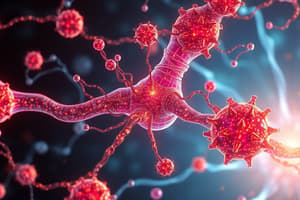Podcast
Questions and Answers
Curare was originally used in South America for hunting purposes.
Curare was originally used in South America for hunting purposes.
True (A)
Curare has no effect on skeletal muscles.
Curare has no effect on skeletal muscles.
False (B)
Curare can be used in combination with anesthetics during surgical procedures.
Curare can be used in combination with anesthetics during surgical procedures.
True (A)
The use of curare leads to increased muscle activity.
The use of curare leads to increased muscle activity.
Curare is a stimulant that enhances muscle contractions.
Curare is a stimulant that enhances muscle contractions.
Physostigmine is an irreversible cholinesterase inhibitor.
Physostigmine is an irreversible cholinesterase inhibitor.
Physostigmine can cross the blood-brain barrier.
Physostigmine can cross the blood-brain barrier.
Curare's action can be countered by increasing the concentration of acetylcholine.
Curare's action can be countered by increasing the concentration of acetylcholine.
Physostigmine decreases the concentration of acetylcholine in the body.
Physostigmine decreases the concentration of acetylcholine in the body.
Curare is classified as either isoquinoline or indole alkaloid.
Curare is classified as either isoquinoline or indole alkaloid.
Kewar is used solely as a local anesthetic during surgeries.
Kewar is used solely as a local anesthetic during surgeries.
Curare can easily cross the blood-brain barrier due to being a non-polar molecule.
Curare can easily cross the blood-brain barrier due to being a non-polar molecule.
The active ingredient in crude curare is D-tubocurarine.
The active ingredient in crude curare is D-tubocurarine.
Curare acts as a non-depolarizing inhibitor of acetylcholine at the neuromuscular junctions.
Curare acts as a non-depolarizing inhibitor of acetylcholine at the neuromuscular junctions.
D-tubocurarine promotes the binding of acetylcholine to nicotinic receptors.
D-tubocurarine promotes the binding of acetylcholine to nicotinic receptors.
Physostigmine can reverse the effects of curare by competing with it for receptors.
Physostigmine can reverse the effects of curare by competing with it for receptors.
Curare is a substance that increases muscle tone and strength.
Curare is a substance that increases muscle tone and strength.
Cholinergic disorders can be treated using physostigmine.
Cholinergic disorders can be treated using physostigmine.
Myasthenia gravis is a condition that worsens with increased levels of acetylcholine.
Myasthenia gravis is a condition that worsens with increased levels of acetylcholine.
Acetylcholine accumulation can lead to decreased muscle power.
Acetylcholine accumulation can lead to decreased muscle power.
Physostigmine is ineffective in improving the memory of Alzheimer's patients.
Physostigmine is ineffective in improving the memory of Alzheimer's patients.
The experiment described involves testing the effects of curare on rabbits.
The experiment described involves testing the effects of curare on rabbits.
Curare has been used solely for recreational purposes and is not used in scientific experiments.
Curare has been used solely for recreational purposes and is not used in scientific experiments.
The anticholinesterase activity of physostigmine makes it useful for treating myasthenic disorders.
The anticholinesterase activity of physostigmine makes it useful for treating myasthenic disorders.
The experiment mentioned evaluates the antagonistic effects of morphine solely.
The experiment mentioned evaluates the antagonistic effects of morphine solely.
Study Notes
Curare
- Curare is an organic compound classified as either isoquinoline or indole alkaloid.
- Curare is an aromatic, nitrogen-containing structure.
- Curare does not cross the blood-brain barrier (BBB) because of the two quaternary nitrogens, making it a polar molecule.
- The active ingredient in crude curare is D-tubocurarine.
Mechanism of Action
- Curare acts as a non-depolarizing and competitive inhibitor of acetylcholine (ACh) at neuromuscular junctions.
- Curare prevents ACh from binding to the nicotinic ACh receptors.
- The binding of curare prevents an action potential from occurring on the postsynaptic membrane.
- This results in paralysis of voluntary muscles.
Uses of Curare
- Curare was discovered in South America and was used as a poison in arrows for hunting.
- Curare has been used in conjunction with general anesthetics, as a paralyzing agent to relax skeletal muscles during surgical procedures.
Physostigmine
- Physostigmine is a parasympathomimetic alkaloid, meaning it mimics the effects of the parasympathetic nervous system.
- Physostigmine can cross the blood-brain barrier.
- Physostigmine is a reversible cholinesterase inhibitor, which means it inhibits the enzyme that breaks down acetylcholine.
- The inhibition of cholinesterase increases the concentration of ACh.
Physostigmine and Curare
- Physostigmine can counteract and reverse the action of curare.
- Since Physostigmine increases ACh, this accumulated ACh can compete with curare for receptors, restoring muscle tone.
Uses of Physostigmine
- Physostigmine is used to treat cholinergic disorders (disorders of the parasympathetic nervous system) and myasthenia gravis (a neuromuscular disease causing weakness of voluntary muscles).
- Physostigmine has also been used to improve memory in Alzheimer's patients due to its potent anticholinesterase activity.
Morphine Experiment
- This experiment was designed to biologically assay curare and evaluate the antagonism effect.
- The experiment uses a rabbit as the animal.
- The drugs used in the experiment are curare and physostigmine, both administered intravenously.
Studying That Suits You
Use AI to generate personalized quizzes and flashcards to suit your learning preferences.
Related Documents
Description
Explore the fascinating properties of curare, an organic compound used historically as a poison and in medicine. This quiz covers its structure, mechanism of action at neuromuscular junctions, and its applications in modern medicine, including surgical use. Test your knowledge on this unique alkaloid and its interactions with acetylcholine.




